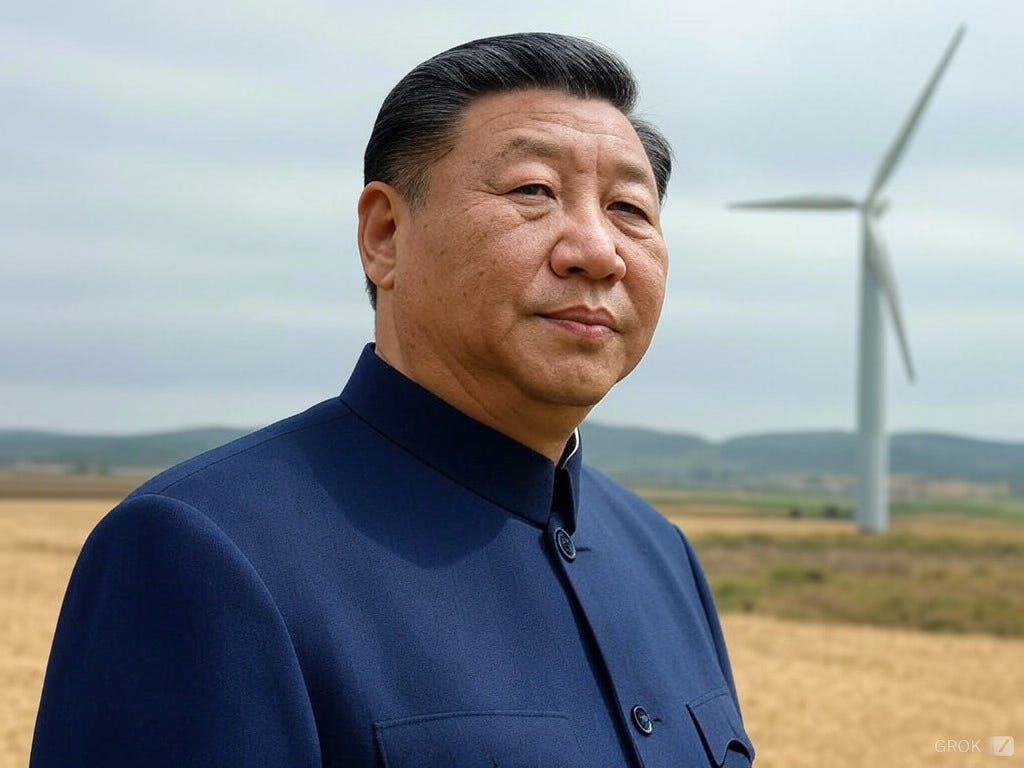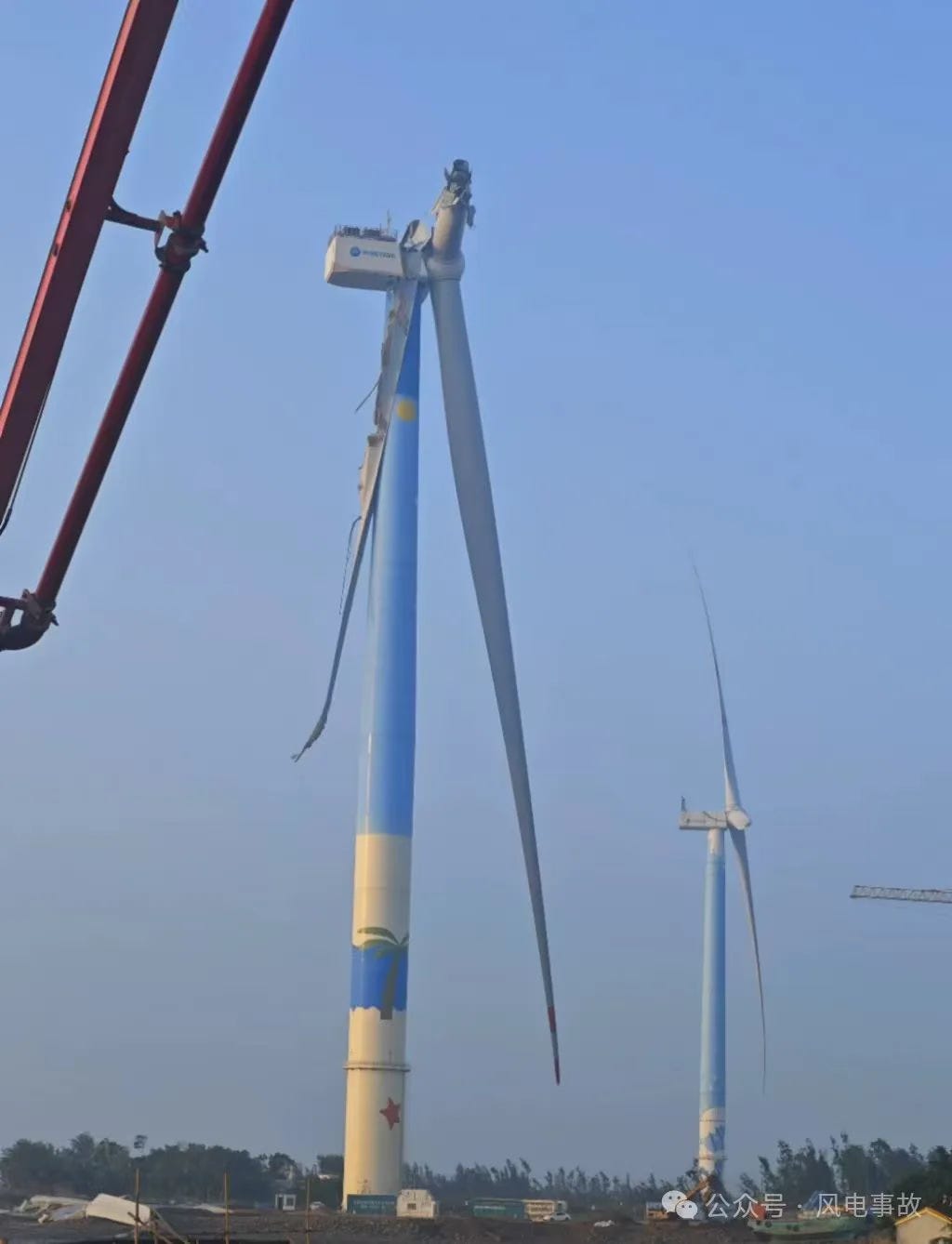If media reports are correct, a prototype Mingyang MySE18X-20MW turbine had two blades break. The first media reports included images of the damaged blades. As far as I can tell, those images have been scrubbed from the internet. Weird.
I did see the images online, briefly. And they didn't look good. Then the images just disappeared. Where did they go? It looks like the media censors in China pulled them down. I found this image on Phil Totaro’s LinkedIn page….
Now let’s have a quasi-adult discussion regarding Chinese manufacturers’ turbines in the United States - and possibly Europe.
When I have discussed the possible use of Chinese manufacturers’ turbines with US operators the answer is generally, “Not a chance.” Now why would that be? The reluctance is two-fold:
Chinese turbines do not have a verifiable service history, and
The energy grid cannot be controlled by the CCP
Let’s deal with Item 1 for now: the turbines lack a verifiable service history.
Service histories are important, for obvious reasons. Most US operators make decisions about purchasing new turbines based on service history. Budgets are based on service histories. Lacking a verifiable service history, how can you support your decision to buy?
Hidden Problems Are Hard To Fix
GE Vernova, Vestas, Siemens Gamesa, Enercon, and Nordex turbines operate in plain sight. They are surrounded by locals. If a turbine is down, the neighbors can see it. The local press writes news stories it. And there are hundreds of technicians and engineers that travel from site to site inspecting and repairing these turbines.
Word spreads quickly about serial defects or common failure points. They become part of the service history. If you don’t believe me, just ask a technician about main bearings replacements. Everybody knows.
Now ask about a Chinese manufacturer’s turbine. Go ahead, ask. Blank stares is all you’ll get.
And here comes the tough part: The Chinese Communist Party (CCP) doesn’t want any disparaging information about their turbines on the internet, if they can avoid it. But that has a consequence. Engineers and financiers and insurers have nothing to make decisions with. If a developer is making a billion-dollar decision on a gaggle of turbines, they want to review the service history.
And if your turbines aren’t working optimally, hiding the problem won’t fix it.
The reluctance of the CCP for an open marketplace is visible in other areas, too. For example, the CCP has set a price floor for Chinese wind turbines to stop a “price war.” Here’s the summary from the October 17, 2024 South China Morning Post:
China’s major wind-turbine manufacturers pledged to end the industry’s prolonged price war, following a similar announcement by the country’s solar-panel industry a few days earlier.
Twelve leading players – including Goldwind, Envision, Mingyang Smart Energy, Shanghai Electric and Dongfeng Electric – signed the promise at a conference in Beijing on Wednesday, agreeing to improve self-discipline in setting prices and avoid price collusion.
Undercutting in the wind-energy industry is hurting manufacturers’ earnings and hindering the sector’s sustainable development, forcing most companies to take losses, said Qin Haiyan, the head of the China Wind Turbine Association.
The article is quick to point out that setting minimum prices is to “avoid price collusion.” What? That is the definition of price collusion.
But why set a price floor? Because energy production, in all forms, is a priority for the CCP.
But is it financially necessary for the Chinese manufactures to sell their turbines in Europe/North America? Nope.
Chinese manufacturers will have a great deal of success in Africa, Southeast Asia, Brazil, and possibly Australia. There are plenty of potential revenue streams for the companies (and the CCP) outside of Europe and North America.
With the inherent risk involved in the design, manufacturing, installation, and operation, why build 20MW turbines? To get an edge on western OEMs? The most likely drivers are China’s sense of national pride and the CCP’s push to be the dominate energy producer in the world. Both could backfire. Both could stymie worldwide wind production.
Too Big to Be Efficient
I hope the European and US wind manufactures don’t follow the Chinese down the 20+ MW path. There are multiple layers of problems to be solved. And the investment in factories, tooling, ships, cranes, is just too much at the moment - especially when the cost of capital is high.
It’s likely the 20MW turbine will be the Airbus A380 of the wind industry. Really cool technology. Breaking multiple engineering barriers. But in the end, it’s just too big for what the industry can handle efficiently today.
Here’s something I hope the European and US wind manufacturers will continue: to be open about problems. That’s the only way to solve them quickly. Explain the solutions, drive down the cost of energy, and make a profit while doing it.
Stay charged!
Allen
PS: To state the obvious, developing industries and markets are fostered, or coddled, by different countries in very, very different ways. To be blunt: China doesn’t play by the same rules as the US, and frankly, most countries have their own rulebooks. But, are some rules so fundamental that they cannot be broken? Like sabotaging another country’s power and data cables? That’s coming up in Tuesday’s Uptime podcast.






Why are gou talking about not moving the 20 MW Path when one European OEM is already ahead of the pack? I think you are misinformed.